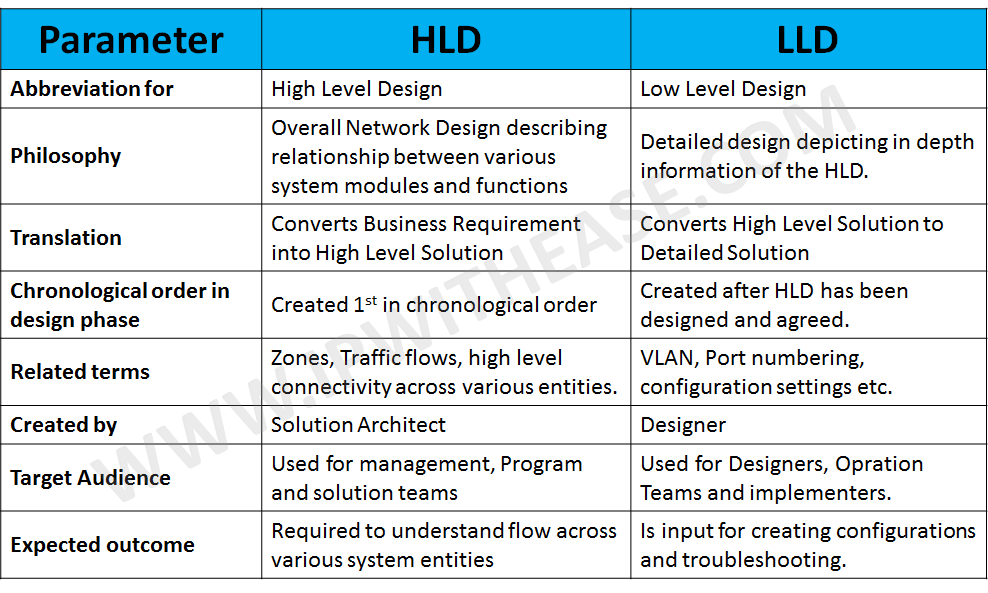Table Of Content

Analyzing successful strategies and designs used in older distributed systems for later use is also known as pattern sharing. So, in a way, you can understand the heart of modern distributed systems by studying the strengths and limitations of older systems. Advanced System Design interviews questions and answers require a deep understanding of distributed systems, particularly their history and evolution. The greater complexity of these systems meant we needed highly scalable and reliable architectures and, consequently, people who could design them. Now, System Design is a cornerstone of modern software development.
How to approach a typical LLD interview?
Whereas LLD gives insights into how well a candidate can model the software. There are several algorithms for performing a topological sort, but one of the most common is the depth-first search (DFS) based algorithm. This repo is an organized collection of resources to help you learn low level design of systesm's. If the entire car is a distributed system, then the engine’s design would be considered a low-level process within that system. The style of design interview you will receive depends on a number of factors. Now that we’ve covered the key differences, let’s look at how you can determine the style of design interview you should expect.
Low-Level OOD
Component-level design is the process of designing the individual components of a software system in detail. It involves defining the structure and behavior of each component, as well as specifying the interfaces between components and any interactions or dependencies between them. The goal of component-level design is to create components that are well-designed, reusable, and easy to maintain. By incorporating these best practices and tips into the low-level design process, developers can navigate the complexities of software architecture more effectively.
Wall Art To Make Your Low Budget House Design Look Classy
Call API “ValidateRole()” to check if a role exists in the database. Various other factors like the API URL, input parameter, response, security feature, and the expected response time for the API call should all be stated for the benefit of the developers. Going through these links and understanding them alone should get you interview-ready. Moreover, you can come up with problems and try applying the design principles while solving them.
GE Research Team Find Critical Adjustments To Improve Wind Turbine Design - NREL
GE Research Team Find Critical Adjustments To Improve Wind Turbine Design.
Posted: Thu, 13 Apr 2023 07:00:00 GMT [source]
Key deliverables of low-level design include detailed component diagrams (e.g., class diagrams, sequence diagrams), data flow diagrams, database schema, and user interface designs. Here, the focus is on the implementation details of a specific module or component within a more extensive system. More specifically, it’s focused on the details of individual classes and objects within that software system and their relationships, methods, and properties. Your interviewers are going to determine how well you can design an efficient implementation that satisfies all of the functional requirements.
During the detailed phase the logical and functional design is done and the design of application structure is developed during the high-level design phase. Each category represents a set of design patterns meant to solve a specific type of object-oriented design problem. By using these patterns, developers can significantly improve their software’s coherence, modularity, and maintainability.
SOLID principles
We read every piece of feedback, and take your input very seriously. To review, here are some major differences between the interviews to remember. Each pattern describes a problem that occurs over and over multiple times in the environment, and their solutions can be applied repeatedly without redundancy.
solutions.md
By carefully selecting and optimizing data structures, developers can create systems that are efficient, easy to use, and able to meet the needs of their users. In low-level designing, developers focus on the specifics of each module or component, considering factors like data storage, data flow, error handling, and performance optimization. The goal is to create a detailed blueprint that developers can use to write the actual code for the system. In this topic, we will concentrate on the brains of the problem solution.
The first thread will perform an database update and the second thread you manage notification. Thus, we have achieved parallelism and have used resources efficiently. Apart from the Sequence diagram, you can draw the Activity diagram as well.
Two-tier kitchen islands are the future – 9 reasons why designers want you to invest now - Homes & Gardens
Two-tier kitchen islands are the future – 9 reasons why designers want you to invest now.
Posted: Wed, 17 May 2023 07:00:00 GMT [source]
If time permits, the code is executed and a few scenarios are tested. The questions would range from “Design a Snake and Ladder Game” to “Design a Social Network like LinkedIn”. The duration of the interview lies somewhere between 60 to 90 mins. I have seen many candidates getting confused between High-level Design and Low-level Design rounds. Once I asked a candidate about an LLD problem, and they started attacking it as an HLD problem. It’s important to know the distinction and communicate during the interview.

The next step is the identify the relationship between the entities. In this article, I’ll share the necessity of the LLD round and its importance. I’ll also cover the necessary skills, strategies, and resources to crack the LLD interviews. Low-level Design rounds have become an integral part of the Tech hiring process. Few companies call it the Pair Programming round or Machine Coding round. Most of the companies ask open-ended questions like “Design a Vending Machine” in this round.
In this section, we delve into case studies to dissect how these principles are applied in actual software development scenarios. By examining concrete examples, we aim to provide insights into the decision-making processes and considerations involved in low-level design. D) This article seeks to unravel the mysteries of low-level design, providing an in-depth exploration of its principles, components, and the impact it has on the overall success of software projects. By understanding the nuances of low-level design, developers can elevate their coding practices, contributing to the creation of systems that not only meet immediate needs but also stand the test of time. When I first started interviewing for software engineer positions, Low-Level OOD interviews were the only type of design interview you’d find yourself in. System Design and scalable systems weren’t as integral as they are today because large-scale distributed systems were relatively uncommon.

No comments:
Post a Comment